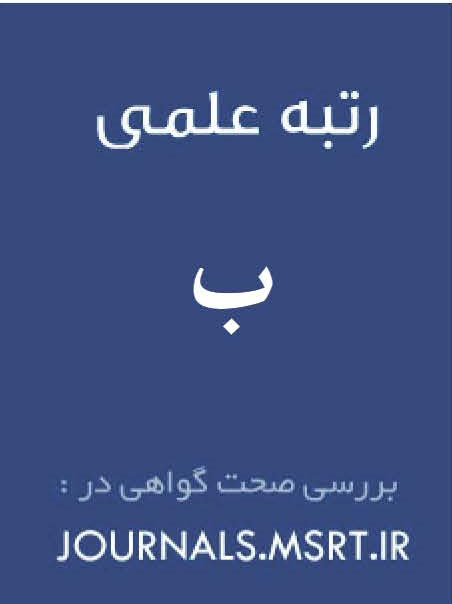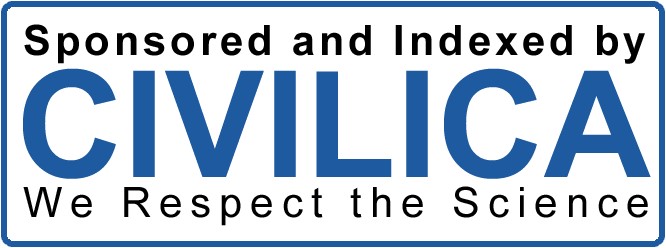Psychometric Properties of the Broad Autism Phenotype Questionnaire in University Students
Keywords:
Autism, Validity, Reliability, PsychometricsAbstract
Objective: The aim of this study was to examine the psychometric properties of the Broad Autism Phenotype Questionnaire in the Iranian population.
Methods and Materials: The statistical population of this study included male students from engineering faculties of universities in Tehran during the 2018–2019 academic year. A total of 240 participants were selected using a multistage random sampling method to take part in the study. The data were analyzed using exploratory and confirmatory factor analysis, Pearson correlation coefficient, and Cronbach's alpha coefficient.
Findings: The exploratory factor analysis supported the three-factor model of the Broad Autism Phenotype Questionnaire, and the results of the confirmatory factor analysis indicated a good model fit for the three-factor structure of the instrument. The pattern of correlations between the subscales of the Broad Autism Phenotype Questionnaire and scores from the alexithymia scale and empathy questionnaire indicated the criterion validity of the questionnaire. The internal consistency of this instrument was above 80%, and the test-retest reliability coefficient demonstrated score stability.
Conclusion: The findings of the present study showed that the Persian version of the Broad Autism Phenotype Questionnaire has an appropriate factor structure, reliability, and validity in the Iranian population.
Downloads
References
Asl, E. M., Mahaki, B., Khanjani, S., & Mohammadian, Y. (2021). The assessment of alexithymia across positive and negative emotions: The psychometric properties of the Iranian version of the perth alexithymia questionnaire. Iranian journal of psychiatry and behavioral sciences, 14(4). https://doi.org/10.5812/ijpbs.102317
Baena, S., Hidalgo, V., & Jiménez, L. (2025). 'That's just the way it is': The experiences of co-habiting Spanish siblings of individuals with autism spectrum disorder. Journal of Child and Family Studies, 1-16. https://doi.org/10.1007/s10826-024-02979-9
Bagby, R. M., Taylor, G. J., & Parker, J. D. (1994). The twenty-item Toronto Alexithymia Scale-II. Convergent, discriminant, and concurrent validity. Journal of psychosomatic research, 38(1), 33-40. https://doi.org/10.1016/0022-3999(94)90006-X
Bargiela, S., Steward, R., & Mandy, W. (2016). The experiences of late-diagnosed women with autism spectrum conditions: An investigation of the female autism phenotype. Journal of Autism and Developmental Disorders, 46(10), 3281-3294. https://doi.org/10.1007/s10803-016-2872-8
Baron-Cohen, S., Wheelwright, S., Skinner, R., Martin, J., & Clubley, E. (2001). The autism-spectrum quotient (AQ): Evidence from asperger syndrome/high-functioning autism, malesand females, scientists and mathematiciansJO - Journal of autism and developmental disorders. 31(1), 5-17. https://doi.org/10.1023/A:1005653411471ER -
Batson, C. D., Fultz, J., & Schoenrade, P. A. (1987). Distress and empathy: Two qualitatively distinct vicarious emotions with different motivational consequences. Journal of personality, 55(1), 19-39. https://doi.org/10.1111/j.1467-6494.1987.tb00426.x
Bishop, D. V., Maybery, M., Maley, A., Wong, D., Hill, W., & Hallmayer, J. (2004). Using self‐report to identify the broad phenotype in parents of children with autistic spectrum disorders: a study using the Autism‐Spectrum Quotient. Journal of Child Psychology and Psychiatry, 45(8), 1431-1436. https://doi.org/10.1111/j.1469-7610.2004.00325.x
Bojanek, E. K., Kelly, S. E., Schmitt, L., Pulver, S. L., Sweeney, J. A., Sprenger, A., Unruh, K. E., & Mosconi, M. W. (2025). Sensorimotor Behavior in Individuals With Autism Spectrum Disorder and Their Unaffected Biological Parents. Autism Research, 18(3), 498-514. https://doi.org/10.1002/aur.70000
Bolton, P., Macdonald, H., Pickles, A., Rios, P. A., Goode, S., Crowson, M., Bailey, A., & Rutter, M. (1994). A case‐control family history study of autism. Journal of Child Psychology and Psychiatry, 35(5), 877-900. https://doi.org/10.1111/j.1469-7610.1994.tb02300.x
Chaki, H. B., & Faran, Y. (2025). The Effect of Family Characteristics on the Functioning of a Child with an Autistic Spectrum Disorder in Bedouin Society in Israel. Journal of Autism and Developmental Disorders, 55(3), 1078-1087. https://doi.org/10.1007/s10803-024-06255-z
Constantino, J. N., & Gruber, C. P. (2012). Social responsiveness scale: SRS-2. Western psychological services. https://www.wpspublish.com/srs-2-social-responsiveness-scale-second-edition.html
Du, X., Gao, S., Huang, T., Liang, J., & Xiao, X. (2025). "Out of sight out of mind": attentional characteristics in mothers who have children with autism. BMC Women's Health, 25(1), 53. https://doi.org/10.1186/s12905-024-03534-w
Elemo, A. S., & Can, E. (2025a). Depression among mothers of children with autism. Psychol Health Med, 30(3), 540-554. https://doi.org/10.1080/13548506.2024.2440655
Elemo, A. S., & Can, E. (2025b). Depression and psychological help-seeking attitude among Turkish mothers of children with autism: problem-focused coping as a mediator. Psychology, Health & Medicine, 30(3), 540-554. https://doi.org/10.1080/13548506.2024.2440655
Godoy-Gimenez, M., Gonzalez-Rodriguez, A., Cañadas, F., Estévez, A. F., & Sayans-Jimenez, P. (2018). Psychometric properties of the Spanish version of the broad autism phenotype questionnaire: Strengths, weaknesses, and future improvements. Journal of Autism and Developmental Disorders, 48(3), 770-783. https://doi.org/10.1007/s10803-017-3438-0
Hull, L., Petrides, K. V., & Mandy, W. (2020). The female autism phenotype and camouflaging: A narrative review. Review Journal of Autism and Developmental Disorders, 7(4), 306-317. https://doi.org/10.1007/s40489-020-00197-9
Hurley, R. S., Losh, M., Parlier, M., Reznick, J. S., & Piven, J. (2007). The broad autism phenotype questionnaire. Journal of Autism and Developmental Disorders, 37(9), 1679-1690. https://doi.org/10.1007/s10803-006-0299-3
Losh, M., Adolphs, R., Poe, M. D., Couture, S., Penn, D., Baranek, G. T., & Piven, J. (2009). Neuropsychological profile of autism and the broad autism phenotype. Archives of General Psychiatry, 66(5), 518-526. https://doi.org/10.1001/archgenpsychiatry.2009.34
Lundström, S., Reichenberg, A., Anckarsäter, H., Lichtenstein, P., & Gillberg, C. (2015). Autism phenotype versus registered diagnosis in Swedish children: prevalence trends over 10 years in general population samples. bmj, 350. https://doi.org/10.1136/bmj.h1961
Meera, S. S., Girimaji, S. C., Seshadri, S. P., Philip, M., Shivashankar, N., Morgan, P., & Piven, J. (2015). Translation of the Broad Autism Phenotype Questionnaire to an Indian language: A description of the process. Asian Journal of Psychiatry, 15, 62-67. https://doi.org/10.1016/j.ajp.2015.04.013
Mottron, L., & Bzdok, D. (2020). Autism spectrum heterogeneity: fact or artifact? Molecular Psychiatry, 25(12), 3178-3185. https://doi.org/10.1038/s41380-020-0748-y
Piven, J., Palmer, P., Jacobi, D., Childress, D., & Arndt, S. (1997). Broader autism phenotype: evidence from a family history study of multiple-incidence autism families. American Journal of Psychiatry, 154(2), 185-190. https://doi.org/10.1176/ajp.154.2.185
Piven, J., Palmer, P., Landa, R., Santangelo, S., Jacobi, D., & Childress, D. (1997). Personality and language characteristics in parents from multiple‐incidence autism families. American Journal of Medical Genetics, 74(4), 398-411. https://doi.org/10.1002/(SICI)1096-8628(19970725)74:4<398::AID-AJMG11>3.3.CO;2-K
Sasson, N. J., Lam, K. S., Childress, D., Parlier, M., Daniels, J. L., & Piven, J. (2013). The Broad Autism Phenotype Questionnaire: Prevalence and Diagnostic Classification. Autism Research, 6(2), 134-143DO - 110.1002/aur.1272. https://pubmed.ncbi.nlm.nih.gov/23427091/
Sung, Y. J., Dawson, G., Munson, J., Estes, A., Schellenberg, G. D., & Wijsman, E. M. (2005). Genetic investigation of quantitative traits related to autism: use of multivariate polygenic models with ascertainment adjustment. The American Journal of Human Genetics, 76(1), 68-81. https://doi.org/10.1086/426951
Wilfert, A. B., Turner, T. N., Murali, S. C., Hsieh, P., Sulovari, A., Wang, T., Coe, B. P., Guo, H., Hoekzema, K., Bakken, T. E., & Winterkorn, L. H. (2021). Recent ultra-rare inherited variants implicate new autism candidate risk genes. Nature Genetics, 53(8), 1125-1134. https://doi.org/10.1038/s41588-021-00899-8
Downloads
Published
Submitted
Revised
Accepted
Issue
Section
License
Copyright (c) 2025 ژاله قربانپور کلاته ملائی, هائیده صابری, سیمین بشردوست (نویسنده)

This work is licensed under a Creative Commons Attribution-NonCommercial 4.0 International License.





